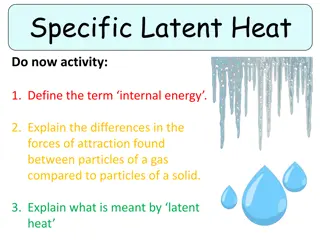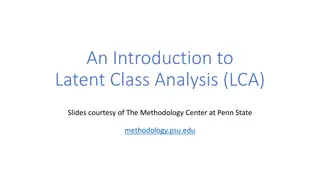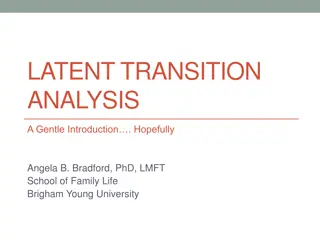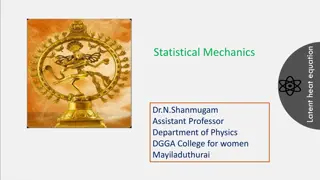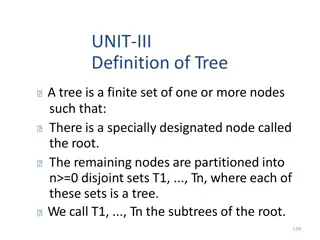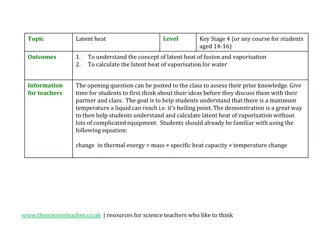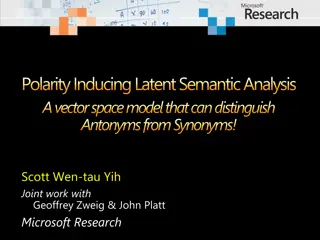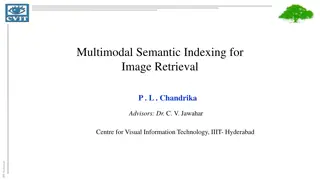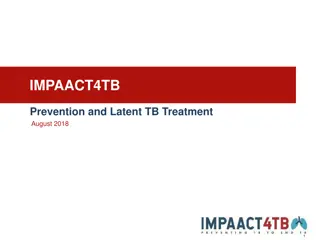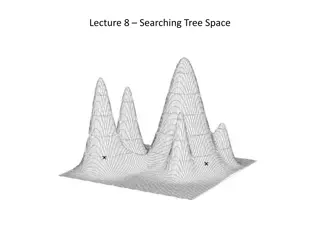Applications of Latent Tree Models in Data Analysis
Latent Tree Models (LTM) offer a versatile approach for data analysis, enabling the discovery of various patterns in different types of data. They are particularly useful for identifying co-occurrence and correlation patterns, as well as uncovering latent structures and variables. With applications in multidimensional clustering, topic detection in text data, probabilistic modeling, and more, LTMs prove valuable across diverse domains such as survey data analysis and approximate probabilistic inference. This tutorial delves into the practical use of LTMs in exploring complex relationships among observed variables and presents methodologies for approximate inference in Bayesian networks through offline and online phases, emphasizing computational efficiency and empirical evaluations with different sample sizes. The tutorial also discusses the effectiveness of alternative models like Chow-Liu tree and latent class models, showcasing a rigorous evaluation process through random queries. Through examples and insights, this tutorial provides a comprehensive overview of the applications and implications of Latent Tree Models in modern data analysis.
Download Presentation

Please find below an Image/Link to download the presentation.
The content on the website is provided AS IS for your information and personal use only. It may not be sold, licensed, or shared on other websites without obtaining consent from the author.If you encounter any issues during the download, it is possible that the publisher has removed the file from their server.
You are allowed to download the files provided on this website for personal or commercial use, subject to the condition that they are used lawfully. All files are the property of their respective owners.
The content on the website is provided AS IS for your information and personal use only. It may not be sold, licensed, or shared on other websites without obtaining consent from the author.
E N D
Presentation Transcript
AAAI 2014 Tutorial Latent Tree Models Part IV: Applications Nevin L. Zhang Dept. of Computer Science & Engineering The Hong Kong Univ. of Sci. & Tech. http://www.cse.ust.hk/~lzhang
Applications of Latent Tree Analysis (LTA) What can LTA be used for: Discovery of co-occurrence patterns in binary data Discovery of correlation patterns in general discrete data Discovery of latent variable/structures Multidimensional clustering Topic detection in text data Probabilistic modelling Applications Analysis of survey data Market survey data, social survey, medical survey data Analysis of text data Topic detection Approximate probabilistic inference AAAI 2014 Tutorial Nevin L. Zhang HKUST 2
Part IV: Applications Approximate Inference in Bayesian Networks Analysis of social survey data Topic detection in text data Analysis of medical symptom survey data Software AAAI 2014 Tutorial Nevin L. Zhang HKUST 3
LTMs for Probabilistic Modelling Attractive Representation of Joint Distributions Computationally very simple to work with. Represent complex relationships among observed variables. What does the structure look like without the latent variables? AAAI 2014 Tutorial Nevin L. Zhang HKUST 4
Approximate Inference in Bayesian Networks In a Bayesian network over observed variables, exact inference can be computationally prohibitive. Two-phase approximate inference: Offline Sample data set from the original network Learn a latent tree model (secondary representation) Online Make inference using the latent tree model. (Fast) (Wang et al. AAAI 2008) Sample Learn LTM AAAI 2014 Tutorial Nevin L. Zhang HKUST 5
Empirical Evaluations Alternatives LTM (1k), LTM (10k), LTM (100k): with different sample size for Phase 1. CL (100k): Phase 1 learns Chow-Liu tree LCM (100k): Phase 1 learns latent class model Loopy Belief Propagation (LBP) Original networks ALARM, INSURANCE, MILDEW, BARLEY, etc. Evaluation: 500 random queries Quality of approximation measured using KL from exact answer. AAAI 2014 Tutorial Nevin L. Zhang HKUST 6
Empirical Results sparse dense C: cardinality of latent variables When C is large enough, LTM achieves good approximation in all cases. Better than LBP on g, d,h Better than CL on d, h. Key Advantage: Online phase is 2 to 3 orders of magnitude faster than exact inference AAAI 2014 Tutorial Nevin L. Zhang HKUST 7
Part III: Applications Approximate Inference in Bayesian networks Analysis of social survey data Topic detection Analysis of medical symptom survey data Software AAAI 2014 Tutorial Nevin L. Zhang HKUST 8
Social Survey Data // Survey on corruption in Hong Kong and performance of the anti-corruption agency -- ICAC //31 questions, 1200 samples C_City: C_Gov: C_Bus: Tolerance_C_Gov: Tolerance_C_Bus: WillingReport_C: LeaveContactInfo: I_EncourageReport: s0 s1 s2 s3 s4 I_Effectiveness: s0 s1 s2 s3 s4 I_Deterrence: .. -1 -1 -1 0 0 -1 -1 -1 -1 -1 -1 0 -1 -1 -1 0 1 1 -1 -1 2 0 2 2 1 3 1 1 4 1 0 1.0 -1 -1 -1 0 0 -1 -1 1 1 -1 -1 0 0 -1 1 -1 1 3 2 2 0 0 0 2 1 2 0 0 2 1 0 1.0 -1 -1 -1 0 0 -1 -1 2 1 2 0 0 0 2 -1 -1 1 1 1 0 2 0 1 2 -1 2 0 1 2 1 0 1.0 . s0 s1 s2 s3 // very common, quite common, uncommon, very uncommon s0 s1 s2 s3 s0 s1 s2 s3 s0 s1 s2 s3 //totally intolerable, intolerable, tolerable, totally tolerable s0 s1 s2 s3 s0 s1 s2 // yes, no, depends s0 s1 // yes, no // very sufficient, sufficient, average, ... //very e, e, a, in-e, very in-e s0 s1 s2 s3 s4 // very sufficient, sufficient, average, ... AAAI 2014 Tutorial Nevin L. Zhang HKUST 9
Latent Structure Discovery Y2: Demographic info; Y3: Tolerance toward corruption; Y4: ICAC performance; Y5: Change in level of corruption; Y6: Level of corruption; Y7: ICAC accountability AAAI 2014 Tutorial Nevin L. Zhang HKUST 10
Multidimensional Clustering Y2=s0: Low income youngsters; Y2=s1: Women with no/low income; Y2=s2: people with good education and good income; Y2=s3: people with poor education and average income. AAAI 2014 Tutorial Nevin L. Zhang HKUST 11
Multidimensional Clustering Y3=s0: people who find corruption totally intolerable; 57% Y3=s1: people who find corruption intolerable; 27% Y3=s2: people who find corruption tolerable; 15% Interesting finding: Y3=s2: 29+19=48% find C-Gov totally intolerable or intolerable; 5% for C-Bus Y3=s1: 54% find C-Gov totally intolerable; 2% for C-Bus Y3=s0: Same attitude toward C-Gov and C-Bus People who are tough on corruption are equally tough toward C-Gov and C-Bus. People who are lenient about corruption are more lenient C-Bus than C-GOv AAAI 2014 Tutorial Nevin L. Zhang HKUST 12
Multidimensional Clustering Who are the toughest toward corruption among the 4 groups? Y2=s2: ( good education and good income) the least tolerant. 4% tolerable Y2=s3: (poor education and average income) the most tolerant. 32% tolerable The other two classes are in between. Summary: Latent tree analysis of social survey data can reveal Interesting latent structures Interesting clusters Interesting relationships among the clusters. AAAI 2014 Tutorial Nevin L. Zhang HKUST 13
Part III: Applications Approximate Inference Analysis of social survey data Topic detection (Analysis of text data) Analysis of medical symptom survey data Software AAAI 2014 Tutorial Nevin L. Zhang HKUST 14
Latent Tree Models for Topic Detection Basics Aggregation of miniature topics Topic extraction and characterization Empirical results AAAI 2014 Tutorial Nevin L. Zhang HKUST 15
What is a topic in LTA? LTM for toy text data Topic: State of latent variable, soft collection of documents Characterized by: Conditional probability of word given latent state, or, document frequency of word in collection: # docs containing the word / total # of docs in the topic Probabilities all words for a topic (in a column) do not sum to 1. Y1=2: oop; Y1=1: Programming; Y1=0: background Background topics for other latent variables not shown.
How are topics and documents are related? Topic: A collection of documents A document is a member of a topic Can belong to multiple topics with different probabilities Probabilities for each document (in each row) do not sum to 1. D97, D115, D205, D528 are documents from the toy text data Table shows: D97 is a web page on OOP from U of Wisconsin Madison D528 is a web page on AI from U of Texas Austin AAAI 2014 Tutorial Nevin L. Zhang HKUST 17
LTA Differs from Latent Dirichlet Allocation (LDA) LDA Topic: Distribution over vocabulary Frequencies a writer would use each word when writing about the topic Probabilities for a topic (in a column) sum to 1 In LDA a document is a mixture of topics (LTA: Topic is a collection of documents) Probabilities in each row sum to 1
Latent Tree Models for Topic Detection Basics Aggregation of miniature topics Topic extraction and characterization Empirical results AAAI 2014 Tutorial Nevin L. Zhang HKUST 19
Latent Tree Model for a Subset of Newsgroup Data Latent variable give miniature topics. Intuitively, more interesting topics can be detected if we combine Z11, Z12, Z13 Z14, Z15, Z16 Z17, Z18, Z19 BI algorithm produces flat models: Each latent variable directly connected to at least one observed variables. AAAI 2014 Tutorial Nevin L. Zhang HKUST 20
Hierarchical Latent Tree Analysis (HLTA) Convert the latent variables into observed one via hard assignment. Afterwards, Z11-Z19 become observed. Run BI on Z11-Z19 AAAI 2014 Tutorial Nevin L. Zhang HKUST 21
Hierarchical Latent Tree Analysis (HLTA) Stack model for Z11-Z19 on top of model for the words Repeat until no more than 2 latent variables or predetermined level reached. The result is called a hierarchical latent tree model (HLTM) AAAI 2014 Tutorial Nevin L. Zhang HKUST 22
Hierarchical Latent Tree Analysis (HLTA) Part II: Cannot determine edge orientations based solely on data. Here hierarchical structure introduced to improve model interpretability. Data + interpretability hierarchical structure. It does not necessarily improve model fit. AAAI 2014 Tutorial Nevin L. Zhang HKUST 23
Latent Tree Models for Topic Detection Basics Aggregation of miniature topics Topic extraction and characterization Empirical results AAAI 2014 Tutorial Nevin L. Zhang HKUST 24
Semantic Base Interpreting states of Z21 Z11, Z12, and Z13 introduced because of co-occurrence of computer , Science ; card , display , ., video ; and dos , windows Z21 introduced because of correlations among Z11, Z12, Z13 So, interpretation of the states of Z21 is to be based on the words in the sub-tree rooted at Z21. They form the semantic base of Z21. AAAI 2014 Tutorial Nevin L. Zhang HKUST 25
Effective Semantic Base Semantic base might be too large to handle. Effective base: Subset of semantic base that matters. Chen et al. AIJ 2012 Sort variables Xi from semantic base in descending of I(Z; Xi). I(Z; X1, , Xi): Mutual information between Z and first i-th variables Estimated via sampling, increases with i. I(Z; X1, , Xm): Mutual information between Z and all m variables in semantic base Information coverage of the first i-th variable I(Z; X1, , Xi)/ I(Z; X1, , Xm): Effective semantic base: Set of leading variables with information coverage higher than a certain level, i.e., 95%. AAAI 2014 Tutorial Nevin L. Zhang HKUST 26
Z22: Upper: Information coverage Lower: Mutual Information Effective semantic bases are typically smaller than Semantic bases. Z22: Semantic base --10 variables, Effective semantic base 8 variable Differences are much larger in models with hundreds of variables. Words are the front are more informative in distinguishing between the states of the latent variable.
Topic Characterizations HLTA characterizes Latent state (topics) using probabilities of words from effective semantic base NOT sorted according to probability, but mutual information Topic Z22=s1 characterized using words Occur with high probabilities in documents on to the topic, and Occur with low probability in documents NOT on the topic. LDA, HLDA, Topic characterized using words that occur with highest probability in the topic. Not necessarily the best words to distinguish the topic from other topics. AAAI 2014 Tutorial Nevin L. Zhang HKUST 28
Latent Tree Models for Topic Detection Basics Aggregation of miniature topics Topic extraction and characterization Empirical results AAAI 2014 Tutorial Nevin L. Zhang HKUST 29
Empirical Results Show the results of HLTA on real-world data Compare HLTA with HLDA and LDA AAAI 2014 Tutorial Nevin L. Zhang HKUST 30
NIPS Data 1,740 papers published at NIPS between 1988 1999. Vocabulary: 1,000 words selected using average TF-IDF. HLTA produced a model with 382 latent variables, arranged on 5 levels. Level 1 279; Level 2 72; Level 3 - 21; Level 4 - 8; Level 5 - 2 Example topics on next few slides Topic characterizations, topic sizes, Topic groups, topic group labels. For details: http://www.cse.ust.hk/~lzhang/ltm/index.htm AAAI 2014 Tutorial Nevin L. Zhang HKUST 31
HLTA Topics: Level-3 likelihood likelihood bayesian conditional conditional 0.34 likelihood bayesian statistical conditional 0.16 gaussian covariance variance matrix 0.21 eigenvalues matrix gaussian covariance bayesian statistical statistical gaussian gaussian reinforcement reinforcement markov transition transition 0.20 markov speech speaker hmms hmm 0.14 speech hmm speaker hmms markov 0.13 reinforcement sutton barto policy actions 0.10 reinforcement sutton barto actions policy markov speech hmm speech hmm trained trained classification classifier classification classifier regression classifiers regression classifiers 0.25 validation regression svm machines 0.07 svm machines vapnik regression 0.38 trained test table train testing 0.30 classification classifier classifiers class cl cells cells neurons cortex firing visual neurons cortex firing visual 0.17 visual cells cortical cortex activity 0.27 cells cortex cortical activity visual 0.33 neurons neuron synaptic synapses 0.18 membrane potentials spike spikes firing 0.15 firing spike membrane spikes potentials 0.18 circuit voltage circuits vlsi chip 0.26 dynamics dynamical attractor stable attractors images images image pixel pixels image pixel pixels object 0.25 images image pixel pixels texture 0.16 receptive orientation objects object 0.21 object objects perception receptive object hidden propagation layer hidden propagation layer backpropagation units units 0.40 hidden backpropagation multilayer architecture architectures 0.40 propagation layer units back net backpropagation ..
HLTA Topics: Level-2 markov markov speech hmm speaker speech hmm speaker hmms 0.14 markov stochastic hmms sequence hmm 0.10 hmm hmms sequence markov stochastic 0.15 speech language word speaker acoustic 0.06 speech speaker acoustic word language 0.16 delay cycle oscillator frame sound 0.10 frame sound delay oscillator cycle 0.14 strings string length symbol hmms reinforcement reinforcement sutton 0.12 transition states reinforcement reward 0.10 reinforcement policy reward states 0.14 trajectory trajectories path adaptive 0.12 actions action control controller agent 0.09 sutton barto td critic moore sutton barto barto actions policy actions policy
HLTA Topics: Level-2 likelihood likelihood bayesian posterior posterior 0.34 likelihood statistical conditional density 0.35 entropy variables divergence mutual 0.19 probabilistic bayesian prior posterior 0.11 bayesian posterior prior bayes 0.15 mixture mixtures experts latent 0.14 mixture mixtures experts hierarchical 0.34 estimate estimation estimating estimated 0.21 estimate estimation estimates estimated bayesian statistical conditional statistical conditional regression validation regression validation vapnik machines machines 0.24 regression svm vapnik margin kernel 0.05 svm vapnik margin kernel regression 0.19 validation cross stopping pruning 0.07 machines boosting machine boltzmann vapnik svm svm classification classification classifier classifiers class classifier classifiers class classes classes 0.28 classification classifier classifiers class 0.24 discriminant label labels discrimination 0.13 handwritten digit character digits gaussian gaussian covariance matrix variance covariance matrix variance eigenvalues eigenvalues 0.09 matrix pca gaussian covariance variance 0.23 gaussian covariance variance matrix pca 0.09 pca gaussian matrix covariance variance 0.18 eigenvalues eigenvalue eigenvectors ij 0.15 blind mixing ica coefficients inverse trained test table train testing trained test table train testing 0.38 trained test table train testing 0.44 experiments correct improved improvement correctly
HLTA Topics: Level-1 likelihood statistical conditional density log likelihood statistical conditional density log 0.30 likelihood conditional log em maximum 0.42 statistical statistics 0.19 density densities mixture mixtures experts hierarchical latent mixture mixtures experts hierarchical latent 0.19 mixture mixtures 0.34 multiple individual missing hierarchical 0.15 hierarchical sparse missing multiple 0.07 experts expert 0.32 weighted sum entropy entropy variables variable divergence variables variable divergence mutual mutual 0.16 entropy divergence mutual 0.31 variables variable estimate estimate estimation estimated estimates estimation estimated estimates estimating estimating 0.38 estimate estimation estimated estimating 0.19 estimate estimates estimation estimated 0.29 estimator true unknown 0.33 sample samples 0.40 assumption assume assumptions assumed 0.27 observations observation observed bayesian bayesian posterior probabilistic prior posterior probabilistic prior bayes 0.19 bayesian prior bayes posterior priors 0.09 bayesian posterior prior priors bayes 0.29 probabilistic distributions probabilities 0.16 inference gibbs sampling generative 0.19 mackay independent averaging ensemble 0.08 belief graphical variational 0.09 monte carlo 0.09 uk ac bayes Reason for aggregate miniature topics: Many Level 1 topics correspond to trivial word co-occurrences , not meaningful
HLTA Topics: Level-4 & 5 Level 5 Level 5 visual visual cortex cells neurons firing cortex cells neurons firing 0.37 visual cortex firing neurons cells 0.39 visual cells firing cortex neurons 0.25 images image pixel hidden trained 0.09 hidden trained images image pixel 0.20 trained hidden images image pixel 0.15 image images pixel trained hidden Level 4 Level 4 visual cortex cells neurons firing visual cortex cells neurons firing 0.34 cells cortex firing neurons visual 0.28 cells neurons cortex firing visual 0.41 approximation gradient optimization 0.29 algorithms optimal approximation 0.39 likelihood bayesian statistical gaussian images images image trained hidden pixel image trained hidden pixel 0.22 regression classification classifier 0.29 trained classification classifier classifiers 0.02 classification classifier regression 0.28 learn learned structure feature features 0.23 feature features structure learn learned 0.24 images image pixel pixels object 0.13 reinforcement transition markov speech 0.14 speech hmm markov transition 0.40 hidden propagation layer backpropagation units
Summary of HLTA Results on NIPS Data Level 1: 279 latent variables Many capture trivial word co-occurrence patterns Level 2: 72 latent variables Meaningful topics, and meaningful topic groups Level 3 : 21 latent variables Meaningful topics, and meaningful topic groups More general than Level 2 topics Level 4: 8 latent variables Meaningful topics, very general Level 5: 2 latent variables Too few In application, one can choose to output the topics at a certain level according the desired number of topics. For NIPS data, either level-2 topics or level-3 topics. AAAI 2014 Tutorial Nevin L. Zhang HKUST 37
HLDA Topics units hidden layer unit units hidden layer unit weight gaussian gaussian log density likelihood estimate log density likelihood estimate margin kernel support xi bound generalization student weight teacher optimal gaussian bayesian kernel evidence posterior chip analog circuit neuron voltage classifier rbf class classifiers classification speech recognition hmm context word ica independent separation source sources image images matching level object tree trees node nodes boosting variables variable bayesian conditional family face strategy differential functional weighting source grammar sequences polynomial regression derivative em machine annealing max min weight control optimal algorithms approximation step control optimal algorithms approximation step policy action reinforcement states actions experts mixture em expert gaussian convergence gradient batch descent means control controller nonlinear series forward distance tangent vectors euclidean distances robot reinforcement position control path bias variance regression learner exploration blocks block length basic experiment td evaluation features temporal expert path reward light stimuli paths Long hmms recurrent matrix term channel call cell channels rl image images recognition pixel feature image images recognition pixel feature video motion visual speech recognition face images faces recognition facial ocular dominance orientation cortical cortex character characters pca coding field resolution false true detection context regression prediction selection criterion query regression prediction selection criterion query validation obs generalization cross pruning mlp risk classifier classification confidence loss song transfer bounds wt principal curve eq curves rules .
LDA Topics inputs outputs trained produce actual dynamics dynamical stable attractor synaptic synapses inhibitory excitatory correlation power correlations cross states stochastic transition dynamic basis rbf radial gaussian centers solution constraints solutions constraint type elements group groups element edge light intensity edges contour recurrent language string symbol strings propagation back rumelhart bp hinton ii region regions iii chain graph matching annealing match context mlp letter nn letters fig eq proposed fast proc variables variable belief conditional i pp vol ca eds ieee units unit hidden connections connected hmm markov probabilities hidden hybrid object objects recognition view shape robot environment goal grid world entropy natural statistical log statistics experts expert gating architecture jordan trajectory arm inverse trajectories hand sequence step sequences length s gaussian density covariance densities positive negative instance instances np target detection targets FALSE normal activity active module modules brain mixture likelihood em log maximum channel stage channels call routing term long scale factor range AAAI 2014 Tutorial Nevin L. Zhang HKUST 39
Comparisons between HLTA and HLDA HLTA Topics HLTA Topics likelihood likelihood bayesian posterior posterior 0.34 likelihood statistical conditional density 0.35 entropy variables divergence mutual 0.19 probabilistic bayesian prior posterior 0.11 bayesian posterior prior bayes 0.15 mixture mixtures experts latent 0.14 mixture mixtures experts hierarchical reinforcement reinforcement sutton sutton barto 0.12 transition states reinforcement reward 0.10 reinforcement policy reward states 0.14 trajectory trajectories path adaptive 0.12 actions action control controller agent 0.09 sutton barto td critic moore HLDA Topics HLDA Topics gaussian gaussian log density likelihood estimate log density likelihood estimate margin kernel support xi bound generalization student weight teacher optimal gaussian bayesian kernel evidence posterior chip analog circuit neuron voltage classifier rbf class classifiers classification speech recognition hmm context word bayesian statistical conditional statistical conditional control optimal algorithms approximation step control optimal algorithms approximation step policy action reinforcement states actions experts mixture em expert gaussian convergence gradient batch descent means control controller nonlinear series forward distance tangent vectors euclidean distances robot reinforcement position control path bias variance regression learner exploration blocks block length basic experiment barto actions policy actions policy HLTA topics have sizes, HLDA/LDA topics do not HLTA produces better hierarchy HLTA gives better topic characterizations AAAI 2014 Tutorial Nevin L. Zhang HKUST 40
Measure of Topic Quality Suppose a topic t is described using M words The topic coherence score for t is: Idea The words for a topic would tend to co-occur. Given a list of words, the more often the words co-occur, than the better the list is as a definition of a topic. Note: Score decreases with M. Topics be compared should be described using the same number of words D. Mimno, H. M. Wallach, E. Talley, M. Leenders, and A. McCallum. Optimizing semantic coherence in topic models. In Proceedings of the Conference on Empirical Methods in Natural Language Processing, pages 262 272, 2011. AAAI 2014 Tutorial Nevin L. Zhang HKUST 41
HLTA Found More Coherent Topics than LDA and HLDA HLTA (L3-L4): All non-background topics from Levels 3 and 4: 47 HLTA (L2-L3-L4): All non-background topics from Levels 2, 3 and 4: 140 LDA was instructed to find two sets of topics with 47 and140 topics HLDA found more 179. HLDA-s: A subset of the HLDA topics were sampled for fair comparison. AAAI 2014 Tutorial Nevin L. Zhang HKUST 42
Comparisons in Terms of Model Fit Regard LDA, HLDA and HLTA as methods for text modeling Build a probabilistic model for the corpus Evaluation: Per-document held-out loglikelihood (-log(perplexity)). Measure performance of model on predicting unseen data Data: NIPS: 1,740 papers from NIPS, 1,000 words, JACM: 536 abstracts from J of ACM, 1,809 words. NEWSGROUP: 20,000 newsgroup posts, 1,000 words. AAAI 2014 Tutorial Nevin L. Zhang HKUST 43
HLTA results robust w.r.t UD-test threshold The values 1, 3, 5 are from literature on Bayes factor (see Part III) LDA produced by far worst models in all cases. HLTA out-performed HLDA on NIPS, tied on JACP, and beaten on Newsgroup Caution: Better model does not implies better topics Running time on NIPS: LDA 3.6 hours, HLTA 17 hours, HLDA 68 hours.
Summary LDA, HLDA Topic: Distribution over vocabulary Don t have sizes Characterization: Words occur with high probability in topic HLTA Topic: collection of documents Have sizes Characterization: Words occur with high probability in topic, low probability in other documents Document: A mixture of topics Document: A member of topic, can belong to multiple topics with probability 1. HLTA produces better hierarchy than HLDA HLTA produce more coherent topics than LDA and HLDA AAAI 2014 Tutorial Nevin L. Zhang HKUST 45
Part III: Applications Approximate Inference in Bayesian networks Analysis of social survey data Topic detection Analysis of medical symptom survey data Software AAAI 2014 Tutorial Nevin L. Zhang HKUST 46
Background of Research Common practice in China, increasingly in Western world Patients of a WM disease divided into several TCM classes Different classes are treated differently using TCM treatments. Example: WM disease: Depression TCM Classes: Liver-Qi Stagnation ( ). Treatment principle: Prescription: Deficiency of Liver Yin and Kidney Yin ( ) Treatment principle: Prescription: Vacuity of both heart and spleen ( ). Treatment principle: , Prescription: . Page 47 AAAI 2014 Tutorial Nevin L. Zhang HKUST 47
Key Question How should patients of a WM disease be divided into subclasses from the TCM perspective? What TCM classes? What are the characteristics of each TCM class? How to differentiate different TCM classes? Important for Clinic practice Research Randomized controlled trials for efficacy Modern biomedical understanding of TCM concepts No consensus. Different doctors/researchers use different schemes. Key weakness of TCM. Page 48 AAAI 2014 Tutorial Nevin L. Zhang HKUST 48
Key Idea Our objective: Provide an evidence-based method for TCM patient classification Key Idea Cluster analysis of symptom data => empirical partition of patients Check to see whether it corresponds to TCM class concept Key technology: Multidimensional clustering Motivation for developing latent tree analysis Page 49 AAAI 2014 Tutorial Nevin L. Zhang HKUST 49
Symptoms Data of Depressive Patients (Zhao et al. JACM 2014) Subjects: 604 depressive patients aged between 19 and 69 from 9 hospitals Selected using the Chinese classification of mental disorder clinic guideline CCMD-3 Exclusion: Subjects we took anti-depression drugs within two weeks prior to the survey; women in the gestational and suckling periods, .. etc Symptom variables From the TCM literature on depression between 1994 and 2004. Searched with the phrase and on the CNKI (China National Knowledge Infrastructure) data Kept only those on studies where patients were selected using the ICD-9, ICD-10, CCMD-2, or CCMD-3 guidelines. 143 symptoms reported in those studies altogether. Page 50 AAAI 2014 Tutorial Nevin L. Zhang HKUST 50










